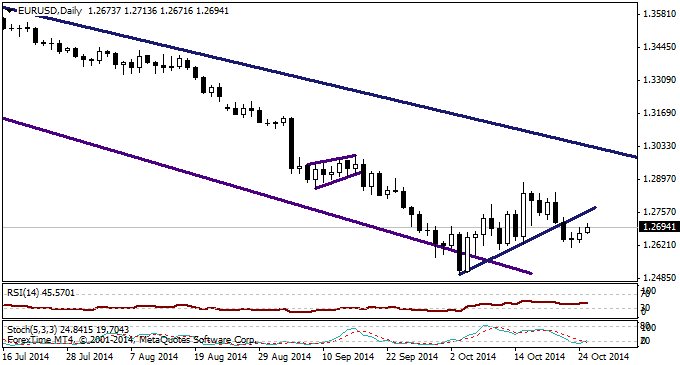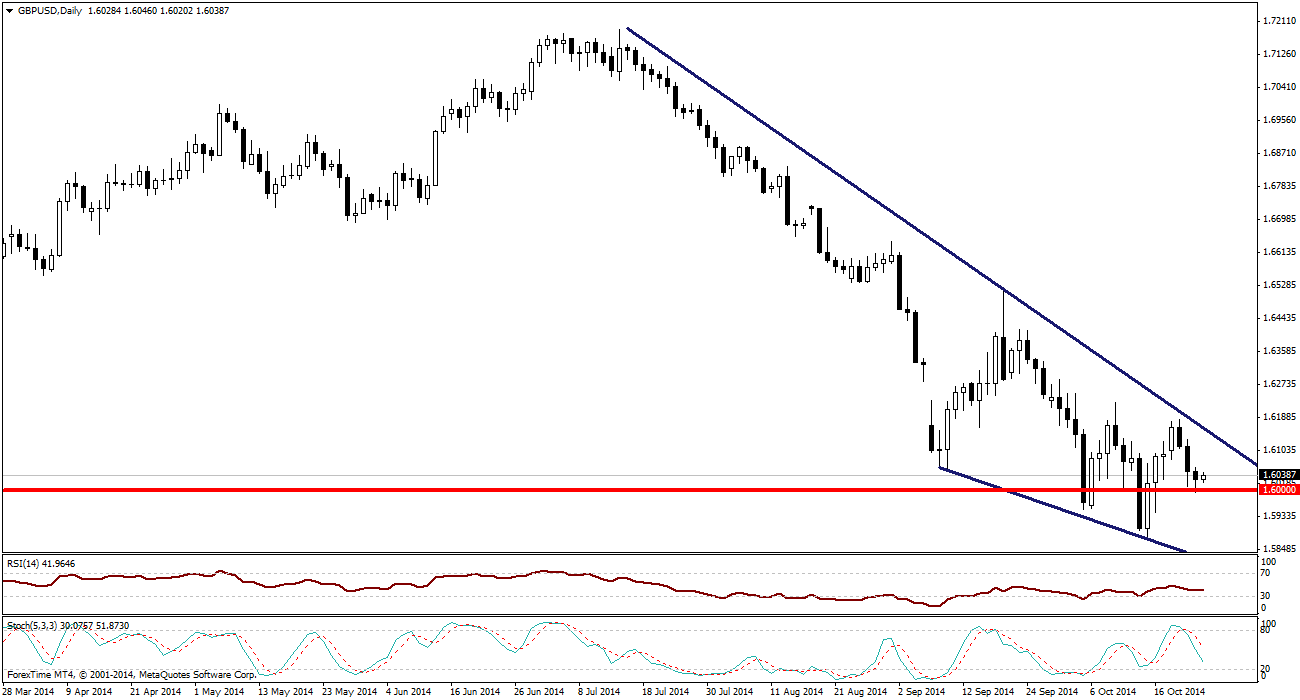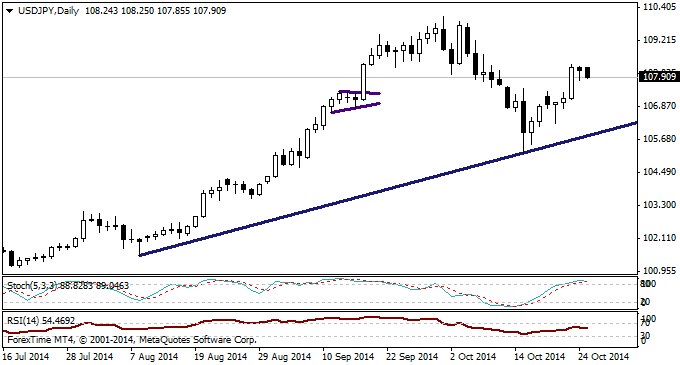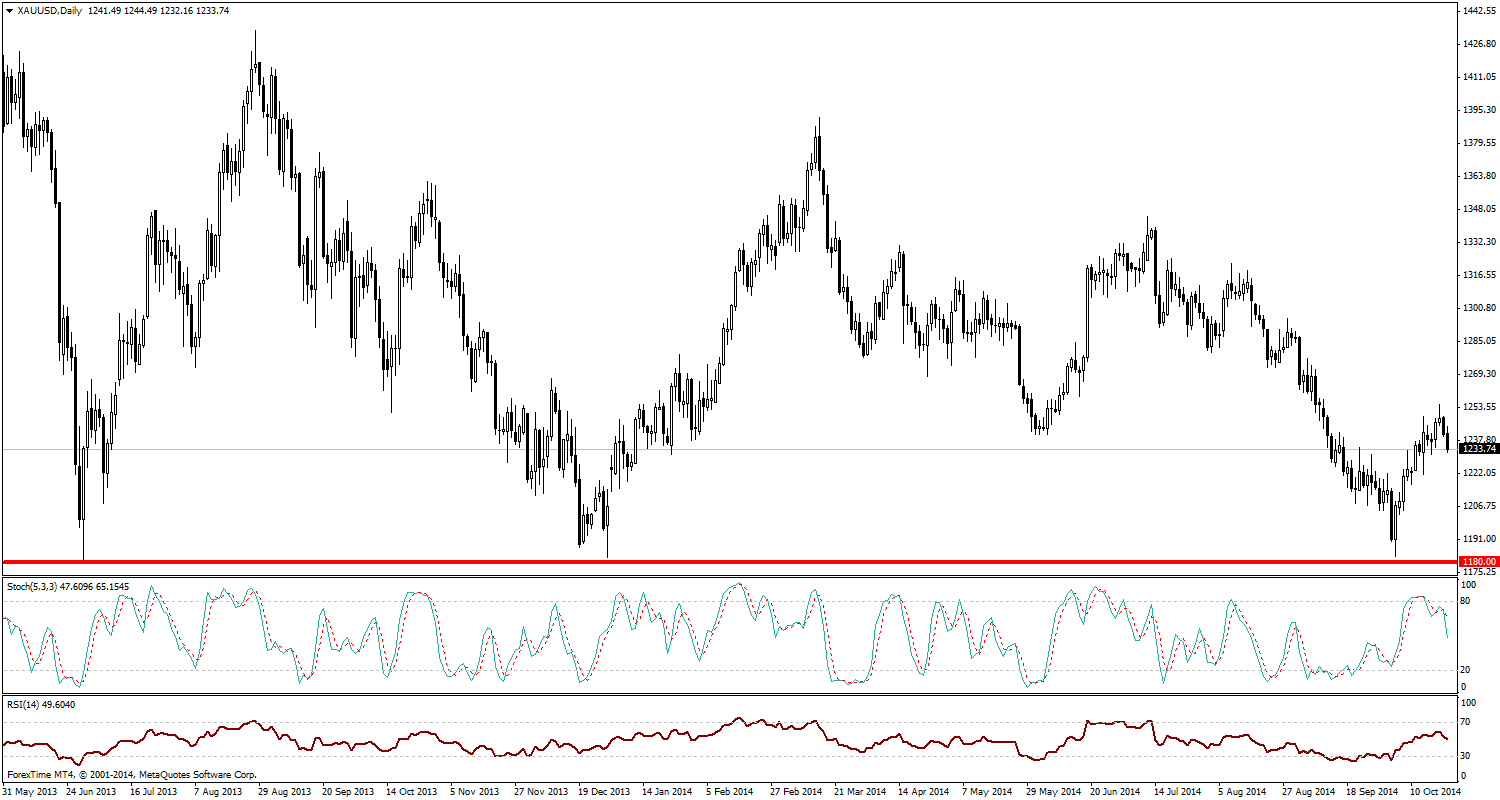EURUSD – Is Germany on the cusp of recession?
Speculation surrounding the possibility of the European Central Bank (ECB) considering extending its asset purchase program in early 2015 encouraged investors to price in further stimulus from the ECB. As such, the EURUSD extended below its recently formed bullish trendline. On the other hand, there are signals that the substantially weaker exchange rate could be helping economic data following both the Services and Manufacturing PMIs coming in above expectations, which encouraged the pair to consolidate as the week concluded.
The upcoming week for the Eurodollar is going to be busy. The majority of the European data is released from Germany, where suspicions remain that the country could be entering another recession. Not only will the latest set of IFO expectations indicate whether business confidence levels are improving following an unexpected economic downturn, but we are also expecting German import data (Tuesday) alongside Unemployment Change and German inflation (Thursday), and on Friday, there is optimism EU inflation will have improved to an annualised 0.4%.
However, as we have regularly seen in the past, the price at which the Eurodollar trades can change in an instant depending on demand for the USD. Wednesday will be an important day for this pair with the US Federal Reserve due to make a pronouncement on economic policy. If they deviate from their existing plan and instead announce the continuation of QE on Wednesday, this will have the knock-on effect of ensuring that an interest rate rise remains a long time away. If this scenario eventuates I would expect widespread USD profit-taking to occur and it would not be a surprise if the EURUSD reversed to the upside and jumped towards 1.28.
Looking at the technicals on the Daily timeframe, the EURUSD remains inside the same bearish channel it has found itself within for a few months. There is room on both the upside and downside for this pair to move over the coming week. Possible resistance can be found at 1.2739, 1.2765 and 1.2839. In regards to support levels, these can be found at 1.2613, 1.2570 and 1.2508.
GBPUSD – Dovish MPC warns of slowing UK economy
In line with expectations, the GBPUSD rollercoaster continued last week with the pair again reversing in direction. The pair declined by close to 100 pips following the Bank of England (BoE) Minutes release sounding far more dovish than expected. The minutes reported that there are signs of the UK economy losing momentum, weak price pressures remain and members of the Monetary Policy Committee (MPC) are apprehensive about premature interest rate rises leaving the UK economy vulnerable to aftershocks.
Not all of the comments were unexpected but the general consensus was that the BoE are probably even more dovish now than what they were before the last meeting. For example, UK inflation has since fallen to 1.2%, far away from the threshold target of 2%, the level at which they will consider a rate rise. Additionally, although Friday’s GDP release came in line with expectations at an annualised 3%, the economy expanded 0.2% less than the previous quarter – meaning the BoE were valid in suggesting economic momentum is slowing.
The upcoming week is very low with UK economic data, meaning the GBPUSD will move according to demand for the USD. From a technical standpoint, the pair found stable support around 1.60 last week, suggesting moves below 1.60 might be limited. I am not expecting Janet Yellen to appear hawkish on Wednesday, enhancing the chances of the GBPUSD benefiting from risk appetite.
For the past couple of weeks, the overall direction the pair has been following has been difficult to forecast. However, I see more potential in this pair advancing to 1.61 – 1.62, than I do in the pair falling to 1.59. Possible resistance can be found at 1.6059, 1.6095 and 1.6160.
USDJPY – Either overextended or consolidating before upside movement
The combination of Japan’s already high trade balance edging higher in September, US CPI calming fears the Federal Reserve will continue QE, alongside improved employment data from the US led to the USDJPY climbing to its highest value since early September.
The chances of USDJPY volatility continuing this week are high, with a wide collection of economic data released from both Japan and the US. Ahead of the FOMC decision on Wednesday, US Durable Goods and Consumer Confidence are both released on Tuesday. While the conclusion of QE on Wednesday would be seen as a sign that the Federal Reserve are moving towards normalizing monetary policy which should strengthen confidence in the USD, traders need to closely monitor how the markets react to Janet Yellen’s comments. If a dovish Yellen dismisses optimism of a US rate rise anytime soon, the chances for widespread USD profit-taking may be high.
From Japan, economic releases at the beginning of the week including Large Retailer Sales and Industrial Production (Tuesday) which are expected to show that buying power is still suffering following the April sales tax. This could encourage speculation that the Bank of Japan (BoJ) will need to increase stimulus, weakening the JPY. However, the BoJ Monetary Policy Statement on Friday morning is expected to reflect the same sentiments as previous statements - that no stimulus will be added anytime soon. An announcement of this nature is could potentially provide the JPY with an opportunity to recover recent losses.
Forecasting the USDJPY’s direction this week is going to be difficult. Durable Goods and Consumer Confidence continuing to display an improving US economic outlook, alongside Japanese Retail Sales and Industrial Production weakening demand for the JPY may provide an opportunity for the pair to progress. However, Yellen dismissing any chances of a US rate rise and the BoJ equally dismissing any chances of further stimulus would be likely to encourage a pull back. Overall, it would not surprise if the USDJPY followed the same pattern as the week before, where it advanced at the beginning of the week and then pulled back as the week concluded.
Gold – Finding resistance at $1255
At the beginning of the week, Gold continued to progress but fell short of surpassing resistance around $1255. Following US inflation coming in higher than forecast, speculation that the Federal Reserve may consider unexpectedly continuing QE calmed down which encouraged Gold to pullback and conclude the week finding support just above $1230.
Gold is potentially entering its most volatile week of the year. I am expecting the Federal Reserve to conclude QE on Wednesday evening and speculation supporting this view should lead to Gold continuing to move lower during the week. However, I am also expecting Federal Reserve Chair, Janet Yellen to completely dismiss any chances of a US interest rate rise anytime soon. If Yellen also attempts to talk down the US economy, there could be potential for Gold to go on one final bull run this year. In the event the Federal Reserve unexpectedly continues QE, the prospects for Gold are bullish.
In reference to my technical observations for Gold on the Daily timeframe, both the Stochastic Oscillator and RSI appear to be currently ranging. This is not unusual with such a key event such as the FOMC decision ahead, but if speculation emerges during the week that the Federal Reserve will conclude QE as planned, the potential is there for Gold to continue extending towards the critical $1180 support level. Support before can be found at $1220 and $1205.
If the opposite occurs and if there is market speculation that the Federal Reserve will continue QE, I would expect sudden bullish movement. Gold has struggled to surpass resistance at $1250 and $1270 previously but the Fed continuing QE would weaken confidence in the US economy, meaning Gold should challenge these levels.
Comparebroker is a comparison site and we spend hundreds of hours to keep the information up to date. However, users are advised to do their own due diligence and nothing can be perceived any advise. The content on the website is purely for education purposes only
Recommended Content
Editors’ Picks
EUR/USD edges lower toward 1.0700 post-US PCE

EUR/USD stays under modest bearish pressure but manages to hold above 1.0700 in the American session on Friday. The US Dollar (USD) gathers strength against its rivals after the stronger-than-forecast PCE inflation data, not allowing the pair to gain traction.
GBP/USD retreats to 1.2500 on renewed USD strength

GBP/USD lost its traction and turned negative on the day near 1.2500. Following the stronger-than-expected PCE inflation readings from the US, the USD stays resilient and makes it difficult for the pair to gather recovery momentum.
Gold struggles to hold above $2,350 following US inflation

Gold turned south and declined toward $2,340, erasing a large portion of its daily gains, as the USD benefited from PCE inflation data. The benchmark 10-year US yield, however, stays in negative territory and helps XAU/USD limit its losses.
Bitcoin Weekly Forecast: BTC’s next breakout could propel it to $80,000 Premium

Bitcoin’s recent price consolidation could be nearing its end as technical indicators and on-chain metrics suggest a potential upward breakout. However, this move would not be straightforward and could punish impatient investors.
Week ahead – Hawkish risk as Fed and NFP on tap, Eurozone data eyed too

Fed meets on Wednesday as US inflation stays elevated. Will Friday’s jobs report bring relief or more angst for the markets? Eurozone flash GDP and CPI numbers in focus for the Euro.



